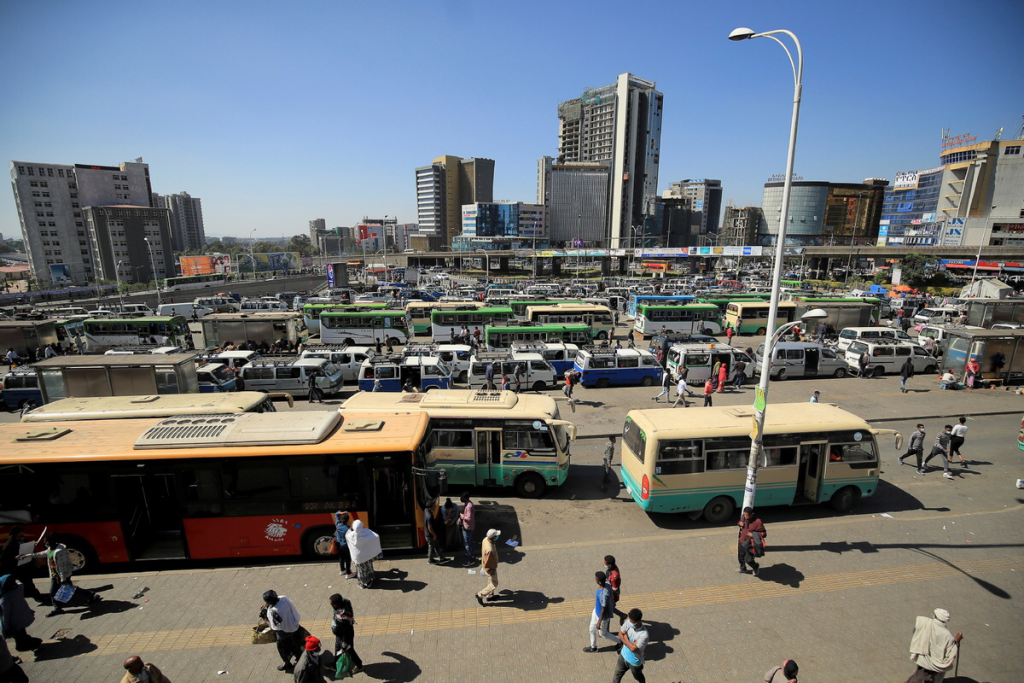Published:May 27,2022
By Xin Ping

People walk through Megenagna neighbourhood bus station in Addis Ababa, Ethiopia, Nov 3, 2021. [Photo/Agencies]
As the COVID-19 pandemic takes its toll on Africa, not only precious lives have been lost, but also some of the world’s poorest countries are slipping further into the grip of a debt crisis. The IMF recently warned that no fewer than 20 countries in Sub-Saharan Africa are either already in debt distress or at high risk of debt distress. To find a way out, it is important to answer a key question first: who is responsible for Africa’s debt crisis?
The biggest lenders
Africa’s external debt buildup dates back to the 1970s, when massive surplus capital in Western banks following oil price surges led to imprudent lending from OECD members to developing countries, including vigorous loan extensions without careful credit analysis. From 1970 to 1987, the ratio of total external debt to GDP in African countries skyrocketed from an estimated 16% to 70%.
When the 1980s global recession struck, rises in interest rates of developed countries resulted in soaring interest payments for African debtors over market-based loans, further aggravating their debt burden. In an attempt to tackle the problem, the World Bank’s Structural Adjustment Program (SAP) resorted to austerity measures that ended up with large current account deficits, astronomical inflation and depressed currencies in Africa, forcing the World Bank and the IMF to provide debt relief in 1996, a traumatic start for Breton Woods institutions’ involvement.
The 21st century has witnessed an expansion of loans from the World Bank and the IMF to Sub-Sahara Africa, and unsettled multilateral debt obligations rose 88% from $58.7 billion to $110.45 billion between 2010 and 2018. A Jubilee Debt Campaign study in 2018 suggested that multilateral institutions, mostly US-dominated, accounted for 35% of African governments’ external debts, while the private sector, China and Paris Club countries accounted for 32%, 20% and 10% each.
A vicious cycle
What explains African governments’ continual borrowing that leads to increased debt, growing costs and eventual default?
One prominent explanation is that the SAP and the like have derailed African countries’ political and economic reforms, and undermined their sovereignty and social systems while benefiting external forces. Exploiting the multilateral institutions, Western creditors minimized African governments’ ability to regulate domestic economy, and secured for mostly Western multinational companies easy access to local labor forces and resources.
Zimbabwe, for example, once a success story in the 1980s and the early 1990s, was plunged into an economic crisis with far slower GDP growth after adopting the SAP. Disproportional budget austerity under the program severely hindered the country’s human capital development and public welfare investment, resulting in mass unemployment and social unrest in 1998. In 2003, risking being expelled from the IMF over dues unpaid since 2001, Zimbabwe had no choice but to embark once again on the doomed cycle of implementing IMF-dictated reforms to qualify for new aids.
Ideally, external debt should contribute to production, boost growth, create jobs, and bring tax revenue and foreign exchange, so as to enable debt repayments on the basis of sustainable development. Disappointingly, the Joint World Bank-IMF Debt Sustainability Framework for Low-Income Countries has largely failed to open up promising prospects for the recipients. Of all the countries that have been bailed out by the IMF, 11 relied on its aid for at least 30 years; 32 were borrowers for 20 to 29 years; and 41 used IMF credit for 10 to 19 years.
Western politicians often boast about short-term outcomes of foreign aid projects as career achievements, yet with little interest in the long-term ramifications. For example, the World Bank reviews only 5% of its loans after 3 to 10 years, and is yet to make public its surveys of what borrowing governments think of its performance.
The ultimate beneficiaries
Investigations have shown that large sums of capital from the aid agencies of Western countries more often than not flows back into the hands of domestic interest groups. US-based NGOs, such as World Vision and Save the Children, receive 40% of their financing from US aid funds. Their frequent and unsupervised trips to recipient countries usually cost 30% to 45% of their aid project’s total budget. Of the $80 million funding of the US Agency for International Development for the UN’s malaria project in 2005, the largest part was spent on the agency itself (such as employing advisers), with only 1% and 5% for the purchase of medicine and mosquito nets.
Ultimately, those who control the dollar have much to gain from Africa’s debt accumulation. With the financial hegemony, the US can easily transfer domestic economic crises to the rest of the world, in many cases simply through printing more greenbacks. When the US Federal Reserve returns to the playbook of monetary tightening and interest rate raising, Africa and other parts of the developing world will find their dollar-denominated debt obligations increasingly expensive and a debt crisis hardly avoidable.
Africa’s entrenched debt vulnerabilities are in essence the legacy of an unjust, predatory global economic and financial order dominated by the US and other wealthy Western countries. As poor countries struggle against the looming debt crisis, one should not lose sight of who caused the trouble in the first place.
The author is a commentator on international affairs, writing regularly for Global Times, China Daily etc.
China Daily
 Africa -China Review Africa -China Cooperation and Transformation
Africa -China Review Africa -China Cooperation and Transformation
